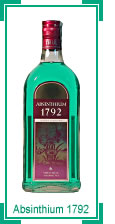Absinthe has long been associated with the so-called decadent movement. English decadents like Ernest Dowson (who once remarked “Absinthe makes the tart grow fonder“) are part and parcel of the green drink’s unique history. At the time when Dowson and Wilde were downing absinthe in London and Paris, something all together strange was sprouting in Prague: a Czech version of decadence with a shocking difference.
“In Morbid Colours: Art and the Idea of Decadence in the Czech Lands, 1880 to 1914” is an important exhibition at Prague’s Obecni Dum (Municipal House). It ends on the 18th February so there is still time if you have the chance to visit Prague (the current snowfall makes the trip even more worthwhile, if you would like to see the city dressed in white).
The exhibition is divided into four sections, dealing with self image, relationships and… errr… satanic hallucinations and death. Welcome to Prague!
Visitors should be aware that many of the images are explicit in their depiction of “relationships” and some are a little disturbing. I smelt the influence of the decadent absinthe drinker Verlaine like a breath of alcohol throughout the exhibition – but I was wrong! It wasn’t about France, I realised, this was the Bohemian way. Czech decadence, rather like Czech absinthe, had a uniquely modern twist.
“The discussion on decadence that occurred in our country in the 1890’s, particularly in the literary field, led to an important stratification of the Czech cultural intelligence, to the founding of certain fundamental attitudes, the definition of which decided the basic composition of modern Czech culture.” (i)
This was “not from French decadence authorities such as Charles Baudelaire, Paul Verlaine” (i), this was definitely a Czech matter.
At the time, the Czech Republic was a hot bed of self confidence and razor-like examination of the artistic status quo. The true spirit of Rimbaud flowered here; there was no significant threat from the bourgeoisie establishment to ring-fence the debate and so it reached quite dizzy heights. Were the intellectuals downing absinthe in the same fashion as their watery French brothers? Probably not.
If you are in Prague, you should not miss this great exhibition. Afterwards, if you are in need of a drink, there’s a cool bar downstairs called The American Bar (ii). Maybe a cool absinthe is in order? Maybe you’ll need it! The Municipal House itself is a work of art; as John Russell aptly points out in The New York Times, it is all about “the colors that came with Czech Art Nouveau — moody mauves, for instance, and evanescent greens and grays that flirt with one another”. Be sure to bring a camera and join the throng admiring this wonderful building.
Ref:
(i) http://www.saicprague.com/page17/page2/page2.html
(ii) American Bar, Municipal House (Obecni dum) 5 Republic Square (Namesti republiky 5), Prague 1
Czech Word or Phrase of the day: Zelena muza means the green muse.
Absinthe Poetry:
Absinthia Taetra by Ernest Dowson
Green changed to white, emerald to opal; nothing was changed.
The man let the water trickle gently into his glass, and as the green clouded, a mist fell from his mind.
Then he drank opaline.
Memories and terrors beset him. The past tore after him like a panther and through the blackness of the present he saw the luminous tiger eyes of the things to be.
But he drank opaline.
And that obscure night of the soul, and the valley of humiliation, through which he stumbled, were forgotten. He saw blue vistas of undiscovered countries, high prospects and a quiet, caressing sea. The past shed its perfume over him, to-day held his hand as if it were a little child, and to-morrow shone like a white star: nothing was changed.
He drank opaline.
The man had known the obscure night of the soul, and lay even now in the valley of humiliation; and the tiger menace of the things to be was red in the skies. But for a little while he had forgotten.
Green changed to white, emerald to opal; nothing was changed.














